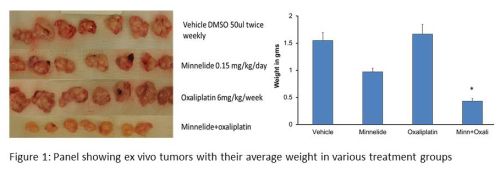|
Back to 2015 Annual Meeting Program
Efficacy of Minnelide and Oxaliplatin Combination Against Pancreatic Cancer
Shrey Modi*, Nivedita Arora, Vikas Dudeja, Sulagna Banerjee, Ashok Saluja
Surgery, University of Minnesota, Minneapolis, MN
INTRODUCTION: Chemoresistance is a hallmark of PDAC. Oxaliplatin has been approved for pancreatic cancer therapy either as first line in FOLFIRINOX or second line in GEMOX/XELOX regimen but with limited efficacy. There are multiple factors responsible for this resistance to oxaliplatin. Minnelide (triptolide prodrug, currently in phase I trials) has been shown to be effective against pancreatic cancer in preclinical trials. In the current study, we evaluated the efficacy of triptolide in sensitizing pancreatic cancer to oxaliplatin.
METHODS: In vitro: Highly aggressive, metastasis derived (S2VP10) and primary tumor derived (MIA PaCa-2) pancreatic cancer cells were treated with oxaliplatin (0-6µM), low dose triptolide (25nM and 50nM) and a combination of both for 24-72h. Cell proliferation was measured using ECIS. Cell viability was measured by WST-8 cell counting kit. Cell death by apoptosis, was evaluated by measuring proportion of active caspase 3 and cleaved PARP positive cells. DNA damage was assessed by measuring positive staining for ɣH2A.X in cancer cells.
In vivo: In an orthotopic model, 5 x 104 MIA PaCa-2 cells were injected into the tail of pancreas of athymic nude mice. Animals were randomized into four groups (N=7) as: DMSO (vehicle); Minnelide 0.15mg/kg/day ip; oxaliplatin 6mg/kg/week in DMSO ip and combination of Minnelide and oxaliplatin. Experiment was terminated after 30 days. Tumors were harvested for use in various experiments.
RESULTS: In vitro, proliferation of pancreatic cancer cells was markedly inhibited by combination treatment. Triptolide (50nM) potentiated apoptotic cell death induced by oxaliplatin in MIA PaCa-2 cancer cells, measured by active capase-3 (24h): control: 0.6 ±0.3%, triptolide (50nM): 9.4 ±0.6%, oxaliplatin (5µM): 2.1 ±1%, combination: 16.7 ±1.2% and cleaved PARP (24h): control: 0.85 ±0.5%, triptolide (50nM): 22.8 ±6.2%, oxaliplatin (5µM): 1.3 ±0.8%), combination: 31.2 ±8%. Triptolide (50nM) sensitized cancer cells towards oxaliplatin induced DNA damage as shown by significantly increased ɣH2A.X positivity in the combination arm (43.2 ±1.2%) vs oxaliplatin alone (26.7 ±1.5%).
In vivo, combination of low doses of Minnelide and oxaliplatin inhibited tumor progression; tumor volumes (vehicle: 2007 ±205 mm3, Minnelide: 1429 ±152 mm3, oxaliplatin: 2228 ±191 mm3, Minnelide + oxaliplatin: 429 ±57 mm3) were significantly reduced in the combination group (Fig.1). TUNEL positive cells were significantly increased in the combination (68.8 ±7.2%) as compared to Minnelide (12.1 ±1.9%) or oxaliplatin alone (10.1 ±1.2%) treated tumors (Fig.2). All data are expressed as mean ±SEM.
CONCLUSION: Low doses of triptolide sensitize pancreatic cancer cells to oxaliplatin induced cell death and combination of Minnelide and oxaliplatin has immense potential to emerge as novel therapeutic strategy against pancreatic cancer.


Back to 2015 Annual Meeting Program
|



